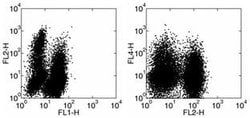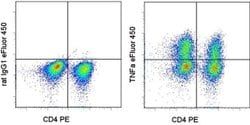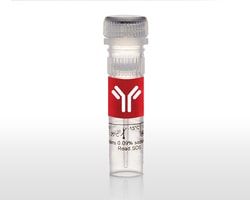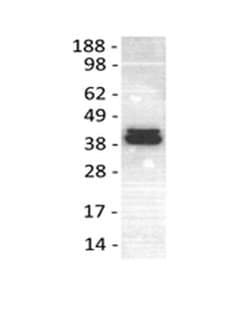TNF alpha Monoclonal Antibody (MP6-XT22), eBioscience™, Invitrogen™
Manufacturer: Fischer Scientific
Select a Size
| Pack Size | SKU | Availability | Price |
|---|---|---|---|
| Each of 1 | 50-112-2725-Each-of-1 | In Stock | ₹ 25,810.00 |
50-112-2725 - Each of 1
In Stock
Quantity
1
Base Price: ₹ 25,810.00
GST (18%): ₹ 4,645.80
Total Price: ₹ 30,455.80
Antigen
TNF alpha
Classification
Monoclonal
Concentration
0.5 mg/mL
Formulation
PBS with 0.09% sodium azide; pH 7.2
Gene Accession No.
P06804
Gene Symbols
Tnf
Purification Method
Affinity chromatography
Regulatory Status
RUO
Gene ID (Entrez)
21926
Content And Storage
4° C
Form
Liquid
Applications
Flow Cytometry, Immunohistochemistry (Frozen)
Clone
MP6-XT22
Conjugate
Unconjugated
Gene
Tnf
Gene Alias
APC1 protein; Cachectin; C-domain 1; C-domain 2; cTNF; DADB-70P7.1; DIF; ICD1; ICD2; Intracellular domain 1; Intracellular domain 2; N-terminal fragment; NTF; RATTNF; Tnf; TNF alpha; TNF superfamily; TNF a; TNF, macrophage-derived; TNF, monocyte-derived; TNFA; TNF-a; TNFalpha; TNF-alpha; Tnfsf1a; TNFSF2; TNFa; TNLG1F; Tumor necrosis factor; tumor necrosis factor (TNF superfamily, member 2); tumor necrosis factor alpha; tumor necrosis factor alpha (cachetin); tumor necrosis factor alpha precursor; tumor necrosis factor ligand 1F; tumor necrosis factor ligand superfamily member 2; Tumor necrosis factor, membrane form; Tumor necrosis factor, soluble form; tumor necrosis factor-alpha; tumor necrosis factor-alpha precursor; tumor-necrosis factor; tumour necrosis factor
Host Species
Rat
Quantity
500 μg
Primary or Secondary
Primary
Target Species
Mouse
Product Type
Antibody
Isotype
IgG1 κ
Related Products
Description
- Description: The MP6-XT22 antibody reacts with mouse tumor necrosis factor-alpha (TNF alpha), a 17 kDa cytokine produced by monocytes, macrophages, neutrophils, NK cells and CD4(+)T cells
- TNF alpha has cytolytic activity against a range of tumor cells and is important in immune regulation
- TNF alpha forms dimers and trimers and also exists as a 26 kDa membrane-bound form
- Applications Reported: This MP6-XT22 antibody has been reported for use in intracellular staining followed by flow cytometric analysis, and immunohistology staining of frozen tissue sections
- (Fluorochrome conjugated MP6-XT22 is recommended for use in intracellular flow cytometry.)
- Applications Tested: The MP6-XT22 antibody has been tested to block staining with fluorochrome conjugated MP6-XT22
- This can be used at less than or equal to 2 μg per test
- A test is defined as the amount (μg) of antibody that will stain a cell sample in a final volume of 100 μL
- Cell number should be determined empirically but can range from 10^5 to 10^8 cells/test
- It is recommended that the antibody be carefully titrated for optimal performance in the assay of interest
- Purity: Greater than 90%, as determined by SDS-PAGE
- Aggregation: Less than 10%, as determined by HPLC
- Filtration: 0.2 μm post-manufacturing filtered
- TNF alpha is a multifunctional proinflammatory cytokine that belongs to the tumor necrosis factor (TNF) superfamily
- This cytokine is mainly secreted by macrophage and bind to its receptors, TNFRSF1A/TNFR1 and TNFRSF1B/TNFBR
- TNF alpha is involved in the regulation of immune cells, cell proliferation, differentiation, apoptosis, lipid metabolism, and coagulation
- TNF alpha exists as a multimer of two, three, or five noncovalently linked units, but shows a single 17 kDa band following SDS-PAGE under non-reducing conditions
- Knockout studies in mice also suggested the neuroprotective function of TNF alpha, and has been observed to causes tumor necrosis when injected into tumor-bearing mice
- Other functions of TNF-alpha include its role in the immune response to bacterial, viral, parasitic and certain fungal infections, as well as its role in the necrosis of specific tumors
- TNF alpha causes cytolysis or cytostasis of certain transformed cells, being synergistic with interferon-gamma in its cytotoxicity
- This cytokine has been implicated in a variety of diseases, including autoimmune diseases, insulin resistance, and cancer.






